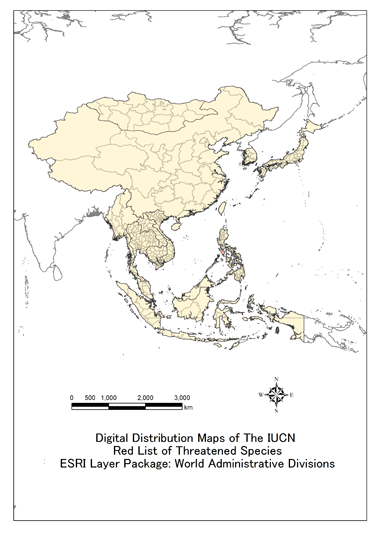
TOP > 生物多様性センターの国際協力 > ESABII > Database > Threatened Mammal Species Database > Sus oliveri

Sus oliveri
Taxonomy (Name)
| Class | MAMMALIAIUCN | |
|---|---|---|
| Order | CETARTIODACTYLAIUCN | |
| Family | SUIDAEIUCN | |
| Scientific Name | Sus oliveriIUCN | |
| Author | Groves, 1997IUCN | |
| Synonyms | ||
| Common Name | Oliver's Warty PigIUCN | |
| Local name | Brunei Darussalam | |
| Cambodia | ||
| China | ||
| Indonesia | ||
| Japan | ||
| Lao PDR | ||
| Malaysia | ||
| Myanmar | ||
| Mongolia | ||
| Philippines | ||
| Singapore | ||
| Republic of Korea | ||
| Thailand | ||
| Vietnam | ||
Picture
Distribution, Range
This species is endemic to the Philippines, where is found only on Mindoro (Heaney et al. 1998). Surveys conducted in the late 1990's indicated the species is now mostly confined to the central and north-western mountain ranges higher elevations.
Map


Country
| Brunei Darussalam | |
|---|---|
| Cambodia | |
| China | |
| Indonesia | |
| Japan | |
| Lao PDR | |
| Malaysia | |
| Myanmar | |
| Mongolia | |
| Philippines | |
| Singapore | |
| Republic of Korea | |
| Thailand | |
| Vietnam |
Status
International Status
IUCN Red List Category
ENIUCN
Justification
Listed as Endangered, because its extent of occurrence is less than 5,000 km2 and its area of occupancy is less than 500 km2, its distribution is severely fragmented, and there is a continuing decline in the extent and quality of its habitat, and in the number of mature individuals to hybridisation and over-hunting.
CITES
CMS
National Status
| Country | Category | Reference |
|---|---|---|
| Brunei Darussalam | ||
| Cambodia | ||
| China | ||
| Indonesia | ||
| Japan | ||
| Korea | ||
| Lao PDR | ||
| Malaysia | ||
| Mongolia | ||
| Myanmar | ||
| Philippines | ||
| Singapore | ||
| Thailand | ||
| Vietnam |
Ecology Discription
Appearance
Habitat
This species was formerly found in most habitats, from sea level to upper montane areas. It now occurs in lowland, mid-montane and dry-molave forests and savanna grasslands (Gonzalez et al1999), being mainly restricted to higher elevations.
Population size
Its population size is unknown, but it is fragmented and declining.
Behavior
Diet
Reproduction
Threat
Major Threat(s)
The main threats to this species include widespread destruction of former forest habitats, evident weaknesses in the existing protected areas network on Mindoro, and anomalies in local legislation pertaining to allowable hunting of threatened versus non-threatened' species by local indigenous peoples. Many (perhaps most) of Mindoro's remaining forest areas are also severely threatened by commercial mining claims and salient 'pro-mining' agendas by many of the relevant Philippine governmental authorities. Genetic contamination via hybridisation with free-ranging domestic pigs maintained in hinterland communities is also known to occur in Mindoro and might pose the single most important threat to the genetic integrity of this species (Gonzalez et al, 1999; W. Oliver pers. comm.). It is also hunted for food, bushmeat trade and local ceremonials.
Conservation and Measurement
International
National
The species occurs in several designated protected areas, though most of these exist only on paper. The clear exception is Mount Iglit-Baco Natural Park, though this area largely comprises of a former cattle ranch and therefore also largely composed of grasslands unlikely to adequately support representative biodiversity in this globally critical region. Reinforcement of existing legislation, more effective protection of the few remaining natural habitats of Mindoro, research to identify pure populations, and increased public awareness, are all needed as a matter of some urgency for the conservation of this and other Mindoron endemic species (Boitani et al. 2006; Gonzalez et al, 1999).
Conservation law
| Country | Status | Reference |
|---|---|---|
| Brunei Darussalam | ||
| Cambodia | ||
| China | ||
| Indonesia | ||
| Japan | ||
| Korea | ||
| Lao PDR | ||
| Malaysia | ||
| Mongolia | ||
| Myanmar | ||
| Philippines | ||
| Singapore | ||
| Thailand | ||
| Vietnam |
Protected Area
The clear exception is Mount Iglit-Baco Natural Park, though this area largely comprises of a former cattle ranch and therefore also largely composed of grasslands unlikely to adequately support representative biodiversity in this globally critical region.
Other Coservation Projects
Citation
Boitani, L., Catullo, G., Marzetti, I., Masi, M., Rulli, M. and Savini, S. 2006. The Southeast Asian Mammal Databank. A tool for conservation and monitoring of mammal diversity in Southeast Asia. Istituto di Ecologia Applicata, Rome, Italy.
Gonzalez, J. C. T., Dans, A. T. L. and Afuang, L. E. 1999. Rapid island-wide survey of terrestrial fauna and flora on Mindoro Island, Philippines. Unpublished report to Philipinas Shell Foundation, and FFI-Philippines Programme.
Groves, C. P. 1997. Taxonomy of wild pigs (Sus) of the Phillipines. Zoological Journal of the Linnean Society 120: 163-191.
Groves, C. P. 2001. Taxonomy of wild pigs of Southeast Asia. IUCN/SSC Pigs, Peccaries, and Hippos Specialist Group (PPHSG) Newsletter 1(1): 3-4.
Grubb, P. 2005. Artiodactyla. In: D. E. Wilson and D. M. Reeder (eds), Mammal Species of the World. A Taxonomic and Geographic Reference (3rd ed), pp. 637-722. Johns Hopkins University Press, Baltimore, USA.
Heaney, L. R., Balete, D. S., Dolar, M. L., Alcala, A. C., Dans, A. T. L., Gonzales, P. C., Ingle, N. R., Lepiten, M. V., Oliver, W. L. R., Ong, P. S., Rickart, E. A., Tabaranza Jr., B. R. and Utzurrum, R. C. B. 1998. A synopsis of the Mammalian Fauna of the Philippine Islands. Fieldiana: Zoology 88: 1-61.
IUCN. 2008. 2008 IUCN Red List of Threatened Species. Available at: http://www.iucnredlist.org. (Accessed: 5 October 2008).
